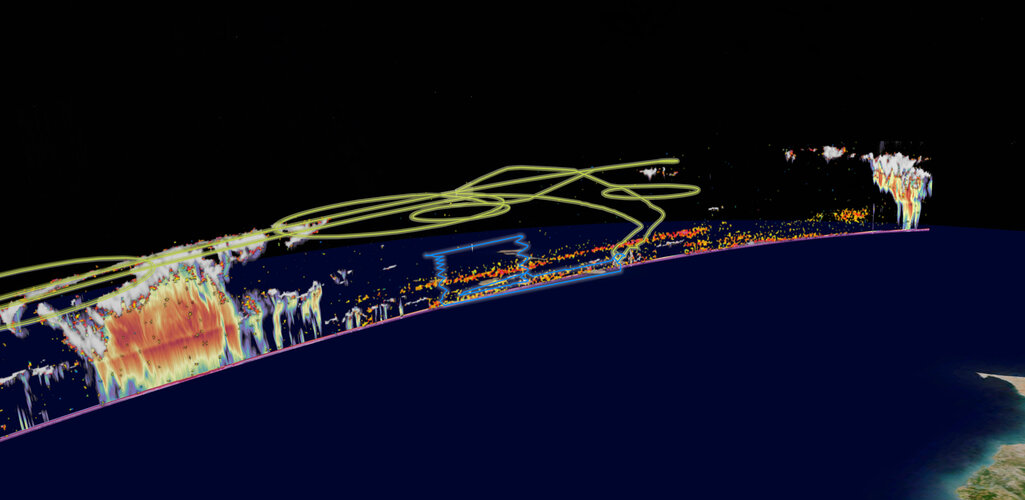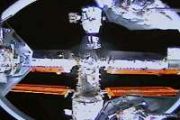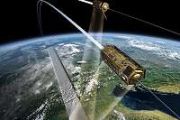
Copernical Team
Taking to the skies for EarthCARE

Launched just six months ago and still in its commissioning phase, ESA’s EarthCARE satellite is already producing remarkable data from its four instruments, offering groundbreaking insights into clouds, aerosols, and Earth’s energy balance.
Highlighting the importance to Earth system science and climate research, teams worldwide are out in force taking measurements to verify and enhance the accuracy of EarthCARE’s data.
How do radar satellites work?
 Video:
00:07:33
Video:
00:07:33
Radar allows us to see through what would otherwise be invisible. By sending out radio waves that bounce off objects and return as echoes, radar creates a detailed picture of our surrounding world.
This technology is everywhere: from guiding air traffic and enabling self-driving cars to tracking the movements of athletes. But its reach doesn’t stop there—radar is also transforming how we observe our Earth from space.
Satellites like the Copernicus Sentinel-1 mission use radar to see through clouds, darkness and any weather conditions. This capability is invaluable for detecting subtle changes on Earth’s surface—changes that are often hidden
Revolv Space prepares for inaugural in-orbit test of SARA system
 Revolv Space has completed integration and testing of its Solar Array Drive Assembly (SADA), known as SARA, on DPhi Space's Clustergate-1 platform, signaling readiness for its first in-orbit demonstration in early 2025. This mission marks a significant step for SARA, showcasing its ability to perform in the rigors of space and establishing its flight credentia
Revolv Space has completed integration and testing of its Solar Array Drive Assembly (SADA), known as SARA, on DPhi Space's Clustergate-1 platform, signaling readiness for its first in-orbit demonstration in early 2025. This mission marks a significant step for SARA, showcasing its ability to perform in the rigors of space and establishing its flight credentia NASA data reveals role of green spaces in cooling cities
 As any urban dweller who has lived through a heat wave knows, a shady tree can make all the difference. But what happens when there's no shade available?
A recent study in Nature Communications used NASA satellite data to identify a major gap in global resilience to climate change: cities in the Global South have far less green space - and therefore less cooling capacity - than cities in t
As any urban dweller who has lived through a heat wave knows, a shady tree can make all the difference. But what happens when there's no shade available?
A recent study in Nature Communications used NASA satellite data to identify a major gap in global resilience to climate change: cities in the Global South have far less green space - and therefore less cooling capacity - than cities in t Shape memory alloy antenna redefines communication technology
 Researchers at Johns Hopkins Applied Physics Laboratory (APL) in Maryland have developed a revolutionary antenna that adjusts its shape based on temperature. Using additive manufacturing and shape memory alloys, the new technology promises significant advancements for military, scientific, and commercial communications. Details of the project are outlined in the journal ACS Applied Engineering M
Researchers at Johns Hopkins Applied Physics Laboratory (APL) in Maryland have developed a revolutionary antenna that adjusts its shape based on temperature. Using additive manufacturing and shape memory alloys, the new technology promises significant advancements for military, scientific, and commercial communications. Details of the project are outlined in the journal ACS Applied Engineering M New AI tool generates realistic satellite images of future flooding
 Visualizing the potential impacts of a hurricane on people's homes before it hits can help residents prepare and decide whether to evacuate.
MIT scientists have developed a method that generates satellite imagery from the future to depict how a region would look after a potential flooding event. The method combines a generative artificial intelligence model with a physics-based flood model
Visualizing the potential impacts of a hurricane on people's homes before it hits can help residents prepare and decide whether to evacuate.
MIT scientists have developed a method that generates satellite imagery from the future to depict how a region would look after a potential flooding event. The method combines a generative artificial intelligence model with a physics-based flood model Long March 12 set for inaugural launch from Hainan space center
 China's Long March 12 carrier rocket is preparing for its debut flight, marking a significant milestone as the first launch from the Hainan International Commercial Aerospace Launch Center. This facility, located in Wenchang, Hainan province, is China's first spaceport dedicated solely to commercial operations.
The rocket was transported to the No. 2 launch service tower at the space compl
China's Long March 12 carrier rocket is preparing for its debut flight, marking a significant milestone as the first launch from the Hainan International Commercial Aerospace Launch Center. This facility, located in Wenchang, Hainan province, is China's first spaceport dedicated solely to commercial operations.
The rocket was transported to the No. 2 launch service tower at the space compl Deep space health risks highlighted in new book by Dr Geoffrey Guy
 Astronauts venturing beyond Earth's protective magnetic and gravitational fields may face significant health risks, according to Quantum Biology - A Glimpse into the Future of Medicine, a new book by Dr Geoffrey Guy. The book explores the emerging field of quantum biology, which examines how sub-atomic processes influence the human body.
Dr Guy argues that traveling outside Earth's "Goldil
Astronauts venturing beyond Earth's protective magnetic and gravitational fields may face significant health risks, according to Quantum Biology - A Glimpse into the Future of Medicine, a new book by Dr Geoffrey Guy. The book explores the emerging field of quantum biology, which examines how sub-atomic processes influence the human body.
Dr Guy argues that traveling outside Earth's "Goldil Spectrum to manufacture satellite components for D-Orbit USA
 Spectrum Advanced Manufacturing Technologies, Inc. (Spectrum), a subsidiary of Ocutrx Technologies, Inc., has been selected as the manufacturing partner for D-Orbit USA, the U.S.-based division of Italian space logistics firm D-Orbit Group. Spectrum will expand its capabilities by renovating a 7,500-square-foot facility, which includes a 2,000-square-foot ISO 8-100,000 Clean Room to assemble sat
Spectrum Advanced Manufacturing Technologies, Inc. (Spectrum), a subsidiary of Ocutrx Technologies, Inc., has been selected as the manufacturing partner for D-Orbit USA, the U.S.-based division of Italian space logistics firm D-Orbit Group. Spectrum will expand its capabilities by renovating a 7,500-square-foot facility, which includes a 2,000-square-foot ISO 8-100,000 Clean Room to assemble sat Kacific introduces SatPack for portable and reliable satellite internet in remote regions
 Kacific Broadband Satellites Group (Kacific) has unveiled SatPack, a portable satellite internet solution designed for rapid deployment in challenging environments across the Asia-Pacific. Building on the success of previous innovations like the CommsBox and CommsBox Ultra, Kacific's SatPack combines portability, reliability, and cost-effectiveness for users requiring immediate connectivity in r
Kacific Broadband Satellites Group (Kacific) has unveiled SatPack, a portable satellite internet solution designed for rapid deployment in challenging environments across the Asia-Pacific. Building on the success of previous innovations like the CommsBox and CommsBox Ultra, Kacific's SatPack combines portability, reliability, and cost-effectiveness for users requiring immediate connectivity in r 




























